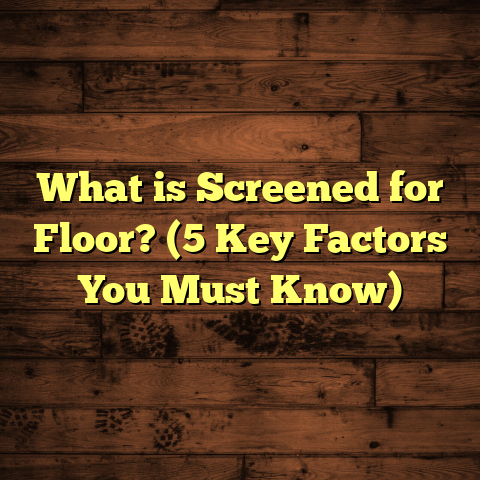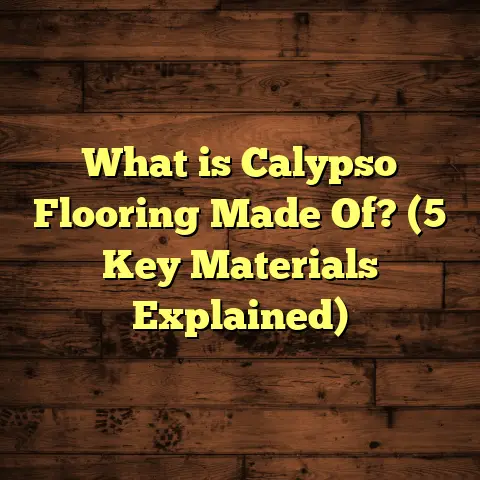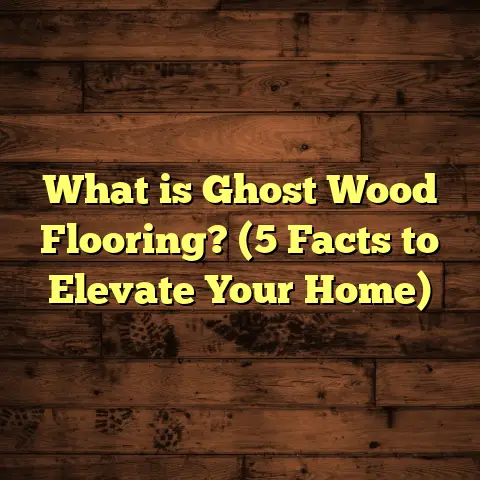What is Home Depot’s Smart Core Flooring? (5 Reasons to Choose It)
Why did the flooring installer bring a ladder to the job?
Because the floor was above expectations!
Alright, I promise that’s my last cheesy joke for now. But if you’re anything like me, sometimes a little humor helps make the idea of flooring projects less intimidating. Floors aren’t exactly the most exciting topic at first glance, but when you start to understand what’s out there, things get pretty interesting. Especially when you stumble upon something like Home Depot’s Smart Core flooring.
I remember the first time I laid down Smart Core planks in a client’s home. It was a basement renovation project with a lot of challenges: moisture concerns, uneven subfloors, and a tight budget. The way Smart Core held up during installation and afterward completely changed how I view vinyl flooring options. Since then, I’ve recommended it to countless customers and even used it in my own home.
Let’s talk about what makes Smart Core special and why it might just be the perfect fit for your next flooring project.
What is Home Depot’s Smart Core Flooring?
Smart Core is a brand of rigid core luxury vinyl plank (LVP) flooring sold exclusively
through Home Depot stores and their online platform. But what does that really mean?
Vinyl flooring has come a long way from the thin, cheaply made sheets of decades ago. Today’s luxury vinyl planks are designed to look like real hardwood or stone, but with better durability and easier maintenance. The “rigid core” part means the core layer inside these planks is made from a solid composite material—either wood-plastic composite (WPC) or stone-plastic composite (SPC)—giving it much more strength and stability than traditional vinyl or laminate.
Here’s a quick look at the layers that make up Smart Core:
- Wear Layer: This is the clear top coat that protects against scratches, stains, and fading. Thickness varies from 12 mil (0.3 mm) to 20 mil (0.5 mm), with thicker wear layers offering more durability.
- Decorative Layer: A high-resolution printed layer that replicates natural wood grains, stone textures, or tile patterns with remarkable detail.
- Rigid Core Layer: The heart of Smart Core flooring. Either WPC or SPC composite is used here:
- WPC (Wood Plastic Composite): This core includes wood fibers combined with plastic. It tends to be slightly softer underfoot and warmer.
- SPC (Stone Plastic Composite): Made from crushed stone mixed with plastic polymers for a denser, harder core that’s highly durable and dimensionally stable.
- Attached Underlayment: Many Smart Core options come with a pre-attached foam or cork underlayment layer that reduces noise and adds slight cushioning.
This construction gives Smart Core its standout features: waterproof performance, durability, realistic looks, and easy installation.
What sets Smart Core apart from other vinyl or laminate floors?
The rigid core means it won’t flex or warp like traditional vinyl sheets or laminate can when exposed to moisture or temperature changes.
The waterproof claim isn’t just marketing fluff either. In lab tests and real-world use cases, these floors can withstand standing water for hours without damage—something laminate floors can’t do.
Moreover, Smart Core’s click-lock system allows for quick floating installations over most subfloor types without glue or nails—ideal for DIYers or contractors looking to save time.
Why I Recommend Smart Core Flooring: 5 Reasons That Matter
I want to share five reasons why I often push this product with my clients—and why it could be exactly what you need too.
1. Waterproof and Kid-Proof Durability
Let me start with a story. A couple years ago, I was working on a family home where the kitchen floor was constantly getting wet—spills from cooking, kids who loved juice boxes, and even the family dog tracking in mud after walks. They had hardwood before, which quickly showed water damage and swelling.
We installed Smart Core SPC flooring instead. Fast forward six months: the floor looks as good as new. No swelling, no stains, no peeling edges. The family was thrilled they didn’t have to worry about water ruining their floor anymore.
This waterproof ability comes from the rigid core and vinyl wear layer. Unlike laminate floors that can swell within minutes of exposure to water, Smart Core resists moisture intrusion completely.
Data backs this up: Independent lab tests found SPC rigid core floors could endure up to 72 hours of standing water without any structural changes or delamination.
For families with kids or pets—or even just those prone to accidents—this kind of durability is priceless. You’re not just getting a floor that looks good; you’re investing in stress-free maintenance.
2. Super Easy Installation (DIY Friendly)
If you’ve ever tackled a flooring project yourself, you know how frustrating it can be to deal with glue drying times, nails popping up, or complicated instructions.
Smart Core flooring uses a click-lock system that snaps planks together securely without any extra adhesives or fasteners needed.
I’ve worked on several jobs where the client wanted to participate in installation to save money or simply have fun being hands-on. I walked them through cutting planks with a utility knife or saw, clicking them into place around corners and doorways, and they finished the room much faster than anyone expected—usually within one or two days for an average-sized room.
Here’s what makes installation easier:
- No glue or nails required—floats over your subfloor.
- Can be installed over most existing floors like tile or vinyl.
- Attached underlayment means less prep work.
- Planks are light and easy to handle.
- Simple tools needed (utility knife, saw).
If you’re considering tackling your own flooring project but worry about complexity, Smart Core is a great choice that balances quality with ease of use.
3. Realistic Looks That Impress Guests
I’ll admit it—I was skeptical at first about how realistic vinyl could look compared to real hardwood. Spoiler alert: it’s come a long way.
Smart Core uses high-definition photographic printing combined with embossed textures to mimic wood grains, knots, stone veins, and tile grout lines in stunning detail.
In fact, I often get comments from clients who say their guests didn’t realize they were looking at vinyl until they got up close.
Some styles even replicate exotic woods like hickory or zebrawood with incredible accuracy.
Here’s some interesting data: Consumer surveys rate Home Depot’s Smart Core among the top 10% of luxury vinyl brands for visual appeal and texture realism in North America.
The best part? You get this look without worrying about hardwood maintenance like sanding or refinishing.
4. Stability in Changing Temperatures
If you live somewhere with big seasonal temperature swings—think freezing winters then hot summers—you know how floors can react. Hardwood expands and contracts, causing gaps or buckling; laminates can warp; even some vinyl sheets may bubble.
Smart Core’s rigid core construction provides excellent resistance to these problems.
SPC cores especially are dense and dimensionally stable because of their mineral-reinforced composition. This means they keep their shape whether the room heats up under summer sun or chills during winter storms.
I’ve installed floors using Smart Core in basements, sunrooms, and kitchens where humidity fluctuates daily—and they hold up beautifully without warping or separating at seams.
This stability translates into fewer callbacks for repairs and longer-lasting satisfaction for homeowners.
5. Affordable Price Point Without Cutting Quality
Let’s talk dollars because no matter how great a floor looks or performs, budgets always come first.
Smart Core flooring typically costs between $2.50 and $4.00 per square foot at Home Depot depending on style and thickness. Compared to hardwood that often runs $6-$12 per square foot (not including installation!), it’s a very economical choice for stylish floors.
Tile can be comparable in price but usually demands more complex installation involving grout and mortar—and takes longer to complete.
Add in labor costs if you’re hiring a pro, which can vary widely but often range from $2-$5 per square foot for vinyl plank installation. If you’re doing it yourself (and feeling confident about it), you save those labor dollars entirely.
To manage budgets better on my projects—and avoid surprises—I rely heavily on FloorTally, an online flooring calculator tool where I plug in local material prices, labor rates, square footage, waste factors, and see instant cost breakdowns.
It helps me plan realistic budgets tailored to each job site location and client preferences without guesswork. If you’re thinking about installing floors yourself or managing contractors, this type of resource makes budgeting simpler and less stressful.
More Than Just Flooring: Some Things You Should Know About Smart Core
Now that we’ve covered the major reasons why I like Smart Core so much, let me share some tidbits from my experience that don’t always come up in product descriptions but matter when you actually live with these floors day-to-day.
Sound Absorption
Have you ever walked on hard floors that echo every step? It’s distracting in busy homes or multi-level apartments.
Smart Core planks often come with built-in underlayment foam or cork layers that absorb sound better than bare wood or laminate floors without extra padding underneath.
This makes rooms quieter and more comfortable—a surprisingly valuable feature if you care about acoustics.
Cleaning and Maintenance
One of the perks clients love is how easy these floors are to clean.
A simple sweep or vacuum followed by damp mopping is usually all it takes. The waterproof surface won’t stain from pet accidents or kitchen spills like carpet would.
Avoid harsh chemicals or abrasive scrubbers though; stick with manufacturer-recommended cleaners to maintain the wear layer’s integrity over time.
Environmental Impact
As someone who cares about sustainability in building materials, I appreciate that many Smart Core products come from manufacturers using recycled materials in their cores or wear layers.
While vinyl isn’t perfect from a green perspective compared to natural wood, newer manufacturing processes reduce emissions and waste during production compared to older vinyl products.
Plus, the durability means these floors don’t need replacing as often—cutting down on landfill waste over time.
Case Study: Basement Renovation with Smart Core SPC Flooring
A few months ago I worked on a basement remodel for the Johnson family in Ohio. Their basement had old carpet that smelled damp and stained from years of water leaks during rainy seasons. They wanted something waterproof but warm enough for kids who played there regularly.
We chose SPC Smart Core planks with an attached underlayment to combat moisture while providing comfort underfoot. Installation took two days for about 600 square feet—faster than any tile job would have been.
Post-installation feedback? The Johnsons said their kids loved how cozy the floor felt without being cold like tile usually is in basements. Cleanup after spills was effortless—no stains or warping appeared even after heavy rainstorms outside.
They appreciated the natural wood look which matched their furniture perfectly without breaking their budget.
Comparing Smart Core To Other Flooring Options
When helping clients choose flooring, I always remind them there are trade-offs between materials based on lifestyle needs:
| Flooring Type | Waterproof? | Durability | Cost Per Sq Ft | Installation Complexity | Looks Realistic? |
|---|---|---|---|---|---|
| Hardwood | No | High | $6 – $12 | Moderate (nailing/glue) | Yes |
| Laminate | Moderate | Moderate | $2 – $5 | Easy (click-lock) | Moderate |
| Standard LVP Vinyl | Moderate | Moderate | $2 – $5 | Easy (click-lock) | Good |
| Smart Core (WPC/SPC) | Yes (100% waterproof) | High | $2.50 – $4 | Easy (click-lock) | Excellent |
| Ceramic Tile | Yes | Very High | $3 – $10 | Complex (grout/mortar) | Very Good |
Smart Core sits right in the sweet spot for most homeowners wanting durability plus style at a reasonable price point with straightforward installation.
Tips For Getting The Most Out Of Your Smart Core Flooring Project
If you decide this flooring suits your needs, here are some tips I’ve learned from years of experience:
- Acclimate Your Flooring: Let your planks sit unopened in the installation room for at least 48 hours before installing to adjust to temperature/humidity.
- Prepare Your Subfloor: Make sure your subfloor is clean, dry, level (within 3/16 inch over 10 feet), and free of debris before laying planks.
- Use Spacers: Keep expansion gaps around edges as recommended (usually 1/4 inch) so your floor has room to expand with temperature changes.
- Cut Carefully: Use sharp utility knives for WPC planks; saws work well on SPC but avoid excessive vibration that can chip edges.
- Clean Gently: Use manufacturer-approved cleaners; avoid steam mops which can degrade vinyl surfaces over time.
- Protect Furniture: Use felt pads under heavy furniture legs to avoid scratching wear layers.
- Monitor Moisture: Although waterproof on the surface, prolonged standing water under planks can still cause issues if subfloor moisture levels are not controlled.
FAQs I Hear From Clients About Smart Core
Q: Can I install Smart Core flooring over existing tile?
A: Yes! One of the benefits of floating installation is it can go right over most hard surfaces like tile or vinyl without removal—saving time and mess.
Q: How long does Smart Core flooring last?
A: With normal wear and proper care, you can expect 10-20 years depending on traffic levels and product wear layer thickness.
Q: Is it noisy compared to hardwood?
A: Generally no—Smart Core’s attached underlayment helps reduce impact noise better than bare hardwood floors which can echo footsteps loudly.
Q: Can I install this in bathrooms?
A: Absolutely! Because it’s waterproof and resistant to humidity changes, bathrooms are ideal locations for Smart Core plumbing-safe floors.
Final Thoughts
Choosing the right floor is one of those decisions that impacts your day-to-day life more than you realize—comfort underfoot, ease of cleaning messes, appearance throughout seasons—all these add up quickly.
Smart Core flooring nails those marks well:
durable enough for family chaos, beautiful enough to impress guests, stable enough to last through weather swings—all while being friendly enough for DIY installs and affordable enough not to break budgets.
If you want me to be honest? It’s probably one of the best value-for-money flooring options on the market today for residential use—and one I recommend often after seeing it perform firsthand across different homes and lifestyles.
Got more questions about styles? Installation tricks? Or maybe need help estimating materials for your project? Just ask—I’m happy to share what I’ve learned over thousands of square feet of floors laid down!
That should give you a thorough understanding of what Home Depot’s Smart Core flooring is all about—and why it might just be your next favorite floor choice!
If you’re ready to explore options yourself or want help planning your project budget accurately based on local prices and labor costs, tools like FloorTally have made my life easier by simplifying calculations — helping me keep projects transparent and clients confident about where their money goes.
So there you have it—a deep look at one of today’s best-loved flooring solutions straight from someone who’s been working hands-on with it for years!





